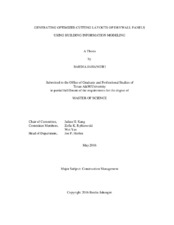| dc.description.abstract | The construction industry generates a substantial amount of solid waste. Cutting building materials into smaller pieces to fit the design is one of the sources of waste in new construction. This type of waste is known as leftover or residual. Drywall leftover is an example of such waste. Currently, contractors do not perform a detailed analysis of how many drywall panels would be required. Moreover, they do not use a consistent system for reusing their scrap and often cut a needed piece from a brand new panel instead of using available scrap.
Building Information Model (BIM), as an object-oriented representation of the building contains all the required data and can be utilized to provide drywall crews with layouts indicating how to cut the panels into the required pieces so the leftover could be reduced. Also, some commercially available software applications, such as Autodesk Revit provide a platform to automate processes such as optimization by implementing algorithms through their Application Programming Interface (API).
Similar problems have been studied in other fields and industries. Bin packing problem in mathematics and Nesting process in the cutting industry are examples of such research. As the result, automated optimization methods that utilize Evolutionary Algorithms (EA) are introduced to address these problems. There is an opportunity to apply Evolutionary Algorithms to solve a similar problem in the construction industry. This study investigates if it is feasible to implement EA-based optimization methods on a BIM platform to develop an automated optimization tool.
In light of available tools and methods, an automated optimization tool is developed as a Revit add-in. It extracts geometrical data from BIM and receives dimensions of available drywall panel(s) from the user. The algorithm, finds the most desirable arrangement of panels and the number of full panels is calculated. The outline of smaller pieces that need to be cut out of full panels are also determined. Then by utilizing an EA-based optimization method, it generates the cutting layouts.
The add-in is tested on a certain number of simple models for several iterations and the generated cutting layouts show very optimal leftover. On a very specific model containing twenty pieces that need to be cut out of full panels, the add-in application spent 100 minutes to generate the cutting layouts, which resulted in 36% reduction in the leftover, compared to the layouts generated in the initial iterations. The test proved that the proposed algorithm is able to optimize cutting layouts. It demonstrates that utilizing such optimization algorithm on a BIM platform could be considered as an effective way to reduce the material waste. | en |


